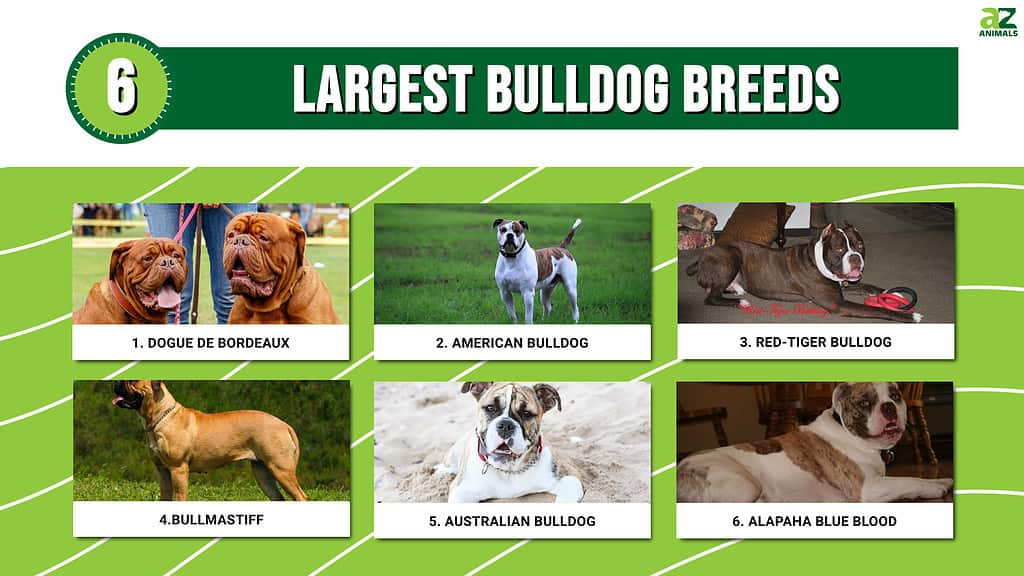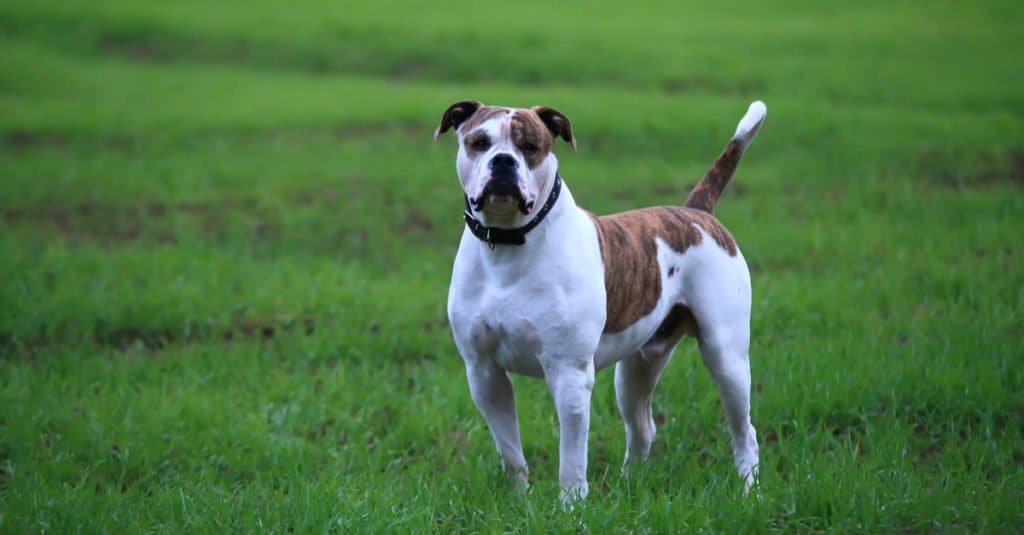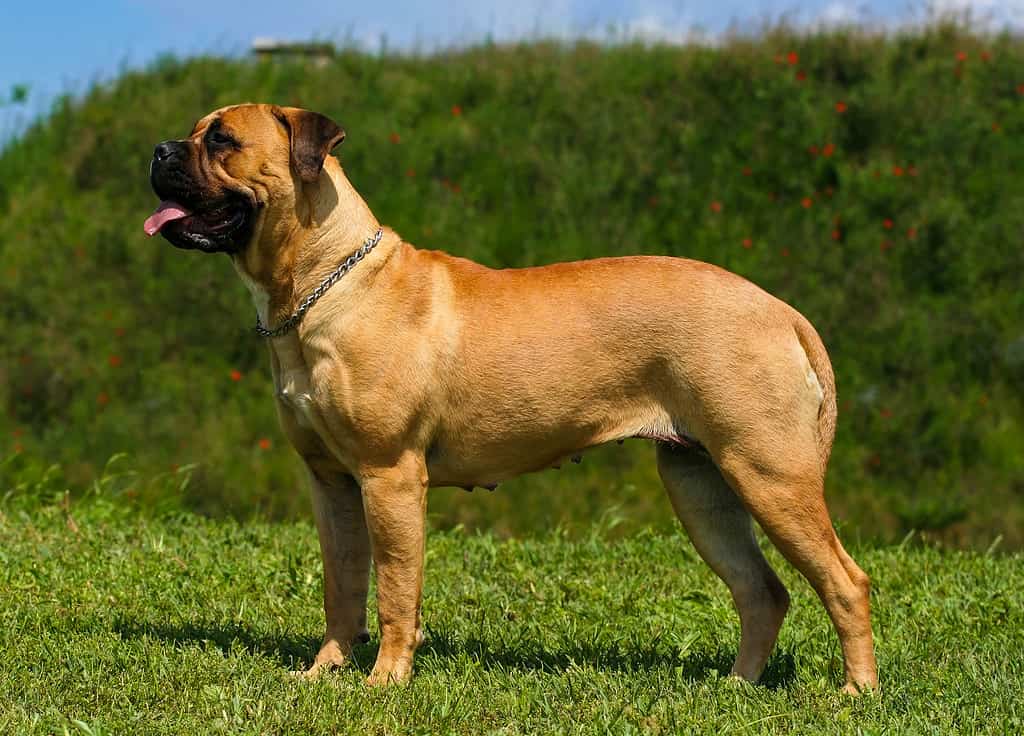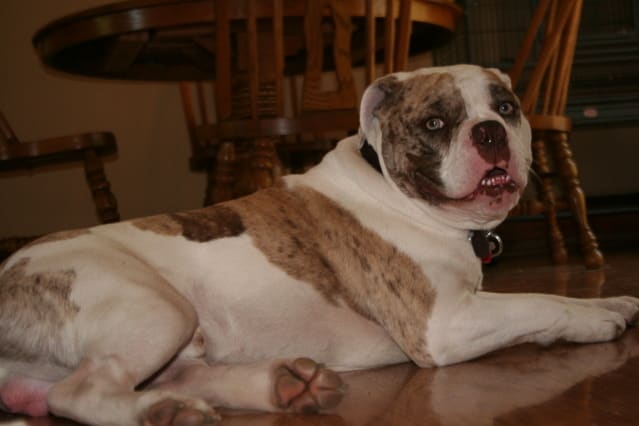Did you know the largest bulldog breeds were used to fight and move livestock throughout the 17th and 18th centuries? Powerful, vicious – and yet super sweet – these dogs have captured the hearts of countless canine lovers in the United States. Two former presidents, Calvin Coolidge, and Warren Harding, couldn’t resist their charm and owned one each.
Like all the creatures roaming our planet, bulldogs come in varying sizes. Some, like the playful and adorable French bulldog, only grow to about 12 inches tall, despite their high price tags. But others are massive, boasting heights of nearly 30 inches as adults.
This article examines the top six largest bulldog breeds. We will unveil their identities and discuss everything about them, including their distinct looks, behavior, and what owners should expect. Let’s dive in!

1. Dogue de Bordeaux
Otherwise called the Bordeaux bulldog or Bordeaux mastiff, the dogue de Bordeaux is an ancient French breed believed to have existed way before France was even recognized as a country. Initially, these dogs were used in war. But they quickly transitioned to guardians, a job they aced due to their undivided loyalty, fearlessness, and protective nature.
The end of the French Revolution saw the dogue de Bordeaux switch careers to drive domestic animals. But as time passed, the dog breed became a beloved family pet, impressing homeowners with its affectionate behavior.
Keepers were captivated by the dogue de Bordeaux’s natural handsomeness. Typically, the dog boasts a short coat with a rich dark-red fawn or light fawn shade. While the males stand at 23-27 inches and weigh at least 110 pounds, adult females are 23-26 inches tall and weigh about 99 pounds. Then, the canine has a large head, a deeply-furrowed brow, and hazel to dark brown expressive eyes beautifully set apart.
Owning a Dogue de Bordeaux
The dogue de Bordeaux certainly makes a great companion—it’s docile and quickly becomes attached to its owner. However, the dog breed is incredibly stubborn, making training a demanding task for most beginner owners.
The dogue de Bordeaux’s enormous size may also present a challenge for owners with inadequate space in their cars or houses. Even more inconvenient, the dog’s lifespan is 5-8 short years. Thus, owning this dog becomes an option only possible if you don’t want long-term companionship. Tragically, this breed is susceptible to several health issues, including:
- Gastric torsion
- Heart diseases
- Bone and joint problems
- Heatstroke
- Cancer

The dogue de Bordeaux is incredibly large and may pose a challenge for owners without adequate space in their cars and houses.
©iStock.com/Yanosh_Nemesh
2. American Bulldog
American bulldogs are also one of the largest bulldog breeds today. These canines, applauded for their super strength, agility, and endurance, are believed to have come to the US in the 1800s alongside British immigrants. They were particularly liked in the southern states for their impressive capability to hunt feral pigs. Moreover, their owners used them as guardians and stock dogs at their farms and ranches.
Most people thought American bulldogs would only last a short time. Despite the species’ large sizes and usefulness, nobody cared for them, and they almost went extinct after the Second World War. But here’s the kicker—war veteran and breeder John D. Jonson bent over backward to revive the species in collaboration with Alan Scott, another passionate breeder.
Appearance, Height, and Weight
The American bulldog’s face lacks the prominent jowls most siblings have. It has a flattened snout and a defined jawline.
While most specimens have brown, almond-shaped eyes, others have hazel, blue, or gray eyes. Heterochromia is also common in this species, so you might find some dogs with blue and brown eyes. Again, their medium-sized ears can be cropped or uncropped; most breeders prefer the latter.
Moreover, the American bulldog is well-built and robust. Most members of this family reach 20-25 inches tall and weigh 60-100 pounds as adults.
Keeping an American Bulldog
American bulldogs bond strongly with their owners, making them great candidates for family pets. These dogs are also skilled athletes who enjoy quality playtime. Therefore, owning one is only great if you’re up for fun training exercises like hikes and jogs. However, we recommend low-impact exercises for puppies to avoid complications like joint injuries.
One aspect setting American bulldogs apart from other canines is they are adept swimmers, unlike many of their siblings. Strangely, plunging into the water tops the list of their least favorite activities. They would do it if they had to, not because they like it. But no matter the exercise you pick for the dog, remember that it dislikes being left alone and will quickly turn to mischief if you let it be.
As a potential American bulldog owner, you should know that these dogs drool. It would be best to keep wiping off the drool because letting it build up paves the way for bacterial build-up and diseases. Still, hypersalivation in this dog breed can also be caused by the following:
- Toxins
- Presence of foreign objects in the mouth
- Facial nerve paralysis
- Dental infections
- Trigeminal neuritis
American Bulldog Lifespan
The American bulldog’s average lifespan is 10-15 years. Most of these dogs are healthy throughout their lives, though some suffer from health concerns like eye problems, obesity, allergies, hip dysplasia, and skin issues.
Nevertheless, you can ensure your American bulldog leads a long, healthy life by providing the best care, including maintaining a proper diet.

The average lifespan of an American bulldog is 10-15 years, and most of them are healthy throughout their lives.
©PixieMe/Shutterstock.com
3. Red-Tiger Bulldog
The red-tiger bulldog is a relatively new breed Rev. Scott L. Amos, Sr. created in 1991, hoping to produce a species with distinct shades. It boasts a unique genetic color composition of reddish-brown or red brindles that have never occurred in the diverse bulldog family. Additionally, the dog features a short and glossy coat. While some specimens have dark ears, others have white markings on their ears and faces.
Red-tiger bulldogs have round or almond-shaped eyes that may come in shades of hazels, yellows, blues, and greens. Individuals with heterochromia are deemed desirable, but those with non-symmetrical eyes are shunned by many. Nevertheless, the dogs can reach heights of 26 inches and weigh up to 115 pounds.
Is the Red-Tiger Bulldog a Great Pet?
Owing to its mild temper and gentleness, the red-tiger bulldog deserves to be on your list of options if you’re hunting for a companion. Since its lifespan is 12-16 years, you’ll have plenty of time to connect and play with the dog. But beware of its high appetite for exercise—it often pushes for playtime when it goes a few days without it. Fortunately, this breed is intelligent and boasts a remarkable memory, so training it is a piece of old tackle.
You should also know that red-tiger bulldogs crave confident and consistent owners. Since the dog shares the same traits, it often tries to please its master, acknowledging the latter’s superiority. However, don’t let the breed’s submissive nature mislead you; the animal has an alpha spirit that sees it bidding to lead its siblings.
Moreover, red-tiger bulldogs are talented predators. Even with regular feeding, they’ll still chase rodents and other small animals on your property. Sometimes, they also become aggressive upon encountering other same-sex dogs.

Red-tiger bulldogs crave confident and consistent owners. Since the dog shares the same traits, it often tries to please its master, acknowledging the latter’s superiority.
4. Bullmastiff
The bullmastiff appeals to keepers looking for large but low-maintenance pets. These dogs are powerful and protective, with short brindle, fawn, or red coats. While their v-shaped ears are naturally floppy, their dark hazel eyes are droopy, allowing them to effectively guilt-trip you when you don’t give in to their demands.
An adult male bullmastiff is usually 25-27 inches tall and weighs 110-130 pounds. On the other hand, most females boast a height of 24-26 inches and weigh 100-120 pounds.
History of the Bullmastiff
English gamekeepers are believed to have cross-bred the now-extinct muscular old English bulldog with the English mastiff to develop the bullmastiff in the 19th century. At the time, they needed guard dogs to protect their territories from poachers.
As the breeders anticipated, the result was a well-built breed that could quickly chase intruders and pin them to the ground long enough to be caught.
Today, the bullmastiff is less aggressive than it was years ago, and instead of guarding estates, they are a pet for many.
Living With a Bullmastiff
Sharing the same space with a bullmastiff is fun because the dog breed is friendly, even to strangers. Since it doesn’t bark as much, noise pollution will be the least of your concerns. Nonetheless, these dogs shed moderately, so you should be ready to groom them at least once monthly. Also, they drool a lot and often snore, meaning letting the pet jump in bed with you is a terrible idea.
You should watch a bullmastiff more closely if you have small kids. Although the dog will probably adore your little ones, it’s enormous and may knock them over trying to play.
Unfortunately, most bullmastiff bulldogs live for 7-8 years. What’s worse, they’re prone to various health issues, such as:
- Food and contact allergies
- Cancer
- Panosteitis
- Thyroid deficiency
- Entropion
- Hip dysplasia
- Gastric torsion

Bullmastiffs are incredibly fun and friendly even to strangers and rarely bark, making them a perfect addition to any family.
©iStock.com/Wavetop
5. Australian Bulldog
Also called the Aussie bulldog, the Australian bulldog was only developed in the 1990s in Queensland. Like its kind, it comes with unmatched loyalty and attractive looks, owing to its diverse coat colors that range from white and fawn to white and red and white and brindle. The dog’s massive, square head is proportional to its sturdy, thickset body. Their uniquely compact build oozes stamina and power.
Moreover, Aussies’ eyes are wide apart. Down below, you’ll find prominent wrinkles running across their noses. Their broad chests and docked tails may help you distinguish them from other members of the bulldog kingdom.
If you’re considering getting an Aussie as a pet, remember that the dogs live for 10-12 years and usually grow to between 16 and 20 inches tall. Fortunately, they’re suited for apartment living, so you don’t have to stress over their shelter.
Owning an Aussie
Australian bulldogs are convenient for most families because they love being part of them. Since they love kids and fun, having a yard where all your loved ones can play is best. When socialized well as puppies, they even like other dogs, making them ideal for keepers interested in multiple dog breeds.
Learning to care for your Aussie properly is essential to keep it happy. Thankfully, it doesn’t require much. Make sure to brush its short coat a few times a week—it helps to maintain its good looks and prevent commonplace skin issues like dermatitis. Meeting the dog’s dietary requirements is also essential for healthy growth.
Furthermore, research some of the health problems the Aussie is prone to if you’re planning on keeping it. For example, these dogs are susceptible to brachycephalic obstructive airway syndrome (BOAS). Unfortunately, the condition is not preventable; the best you can do is learn how to treat it so you’ll be prepared if your furry pal develops it.

Australian bulldogs are convenient for most families because they love being part of them.
©JCM Photos/Shutterstock.com
6. Alapaha Blue Blood
The Alapaha blue blood is a large bulldog that stands 18-24 inches at the shoulder and weighs 55-90 pounds. It was initially bred in southern Georgia in the 1800s to catch headstrong domestic animals like cattle. But as years passed, their owners started perceiving them as pets, which isn’t surprising given that they’re robust, protective, and easy to train. Additionally, these canines come with attractive coats, including bridle, fawn, white and black, and white.
Alapaha blue blood bulldogs have a lifespan of 11-13 years. Start socializing yours in its early years to expose it to different sights and scents. The process is also a great way to teach the dog how to identify between threats. Again, we endorse leashing the canine during walks or other fun outdoor activities. With its high prey drive, it’s likely to wander off to hunt animals like mice and squirrels, increasing its chances of getting lost.
Thankfully, grooming an Alapaha blue blood is a breeze. You only need to brush its short glossy coat once a week to minimize shedding and remove dead hair. In addition, docking the dog’s tail is unnecessary, but we recommend bathing it biweekly to keep it smelling nice and enable you to:
- Look for parasites like fleas.
- Discover any skin issues.
- Improve your furry pal’s looks.
- Minimize the risk of ear and other infections.
- Prevent matting.
Common Alapaha Blue Blood Health Concerns
The Alapaha blue blood is susceptible to deafness, entropion, hip dysplasia, bloating, arthritis, and heart diseases. If you intend to buy one of these large dogs, ask the breeder for documentation to prove it’s free of any underlying illness and inherited medical conditions.
You can also take precautions to ensure your Alapaha blue blood remains healthy. For example, take your furry buddy to a veterinarian often so the professional can help diagnose any problems the dog might have and recommend a preventative or treatment regimen.

This loyal and devoted breed, the Alapaha blue blood bulldog is a great companion for those looking for an active dog with protective instincts.
The Largest Bulldog Breeds Make Perfect Pets
Indeed, owning one of the largest bulldog breeds is a privilege many hope to enjoy. Despite being enormous, these docile canines are predictable and reliable, allowing you to have a companion you can bank on. Although most need a few minutes of daily exercise, some dislike intense activities and are ideal for keepers who enjoy much time indoors.
Please take your time to check the available options on the market before becoming a bulldog parent. Any of our picks above warrants your attention if you’re interested in a gigantic furry pal who’s easy to handle.
But if you’re interested in a smaller pet, you’re still in luck! The bulldog family has other members you might find appealing, such as French and English bulldogs. Other breeds, like affenpinschers, Biewer Terriers, rat terriers, and dachshunds, are also worth a shot.
Summary of the Top 6 Largest Bulldog Breeds
| Rank | Bulldog Breed |
|---|---|
| 1 | Dogue de Bordeaux |
| 2 | American Bulldog |
| 3 | Red Tiger Bulldog |
| 4 | Bullmastiff |
| 5 | Australian Bulldog |
| 6 | Alapaha Blue Blood |
The photo featured at the top of this post is © Danita Delimont/Shutterstock.com
Ready to discover the top 10 cutest dog breeds in the entire world?
How about the fastest dogs, the largest dogs and those that are -- quite frankly -- just the kindest dogs on the planet? Each day, AZ Animals sends out lists just like this to our thousands of email subscribers. And the best part? It's FREE. Join today by entering your email below.
Thank you for reading! Have some feedback for us? Contact the AZ Animals editorial team.







